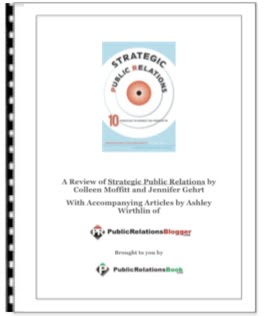________________________________________________________________________
 When, as a business, non-profit or association manager, you are able to persuade your key external stakeholders to your way of thinking, then move them to take actions that lead to your department, division or subsidiary’s success.
When, as a business, non-profit or association manager, you are able to persuade your key external stakeholders to your way of thinking, then move them to take actions that lead to your department, division or subsidiary’s success.
And again when those outside stakeholder behaviors deliver results like more people returning to buy again, new prospects sniffing around, individual capital gift levels rising, or more inquiries arriving about strategic alliances and joint ventures.
It especially matters when the emphasis of the PR team assigned to your unit shifts from communications tactics to a comprehensive blueprint that leads to your personal success as a unit manager. Particularly as it demands of you a sharper focus on the very groups of outside people who play a major role in just HOW successful a manager you will be - your key external audiences.
But, what really matters most about your public relations is the foundation on which you build your program. For example, one like this: people act on their own perception of the facts before them, which leads to predictable behaviors about which something can be done. When we create, change or reinforce that opinion by reaching, persuading and moving-to-desired-action the very people whose behaviors affect the organization the most, the public relations mission is accomplished.
How you implement such a fundamental premise is the enduring key to success. Discuss it with your PR team, especially the importance of learning how your organization is perceived by those target audience members. It should be obvious to all concerned that those perceptions almost always result in predictable behaviors that can help or hinder your operation.
You need to interact with members of the key target audience and ask a lot of questions. “Do you know anything about us? What do you think of our services, products or people, if anything? Have we ever worked together on a project? Was it a positive experience? Do you have any kind of problem with us?”
If budget is not a problem, you can hire a professional survey firm to gather these data. Or, since your PR people are already in the perception and behavior business, you can put them to work doing this very important work.
Whoever does the perception monitoring work should stay alert for negativities, especially attitudes and voice levels. Watch carefully for untruths, misconceptions, inaccuracies or rumors.
Once gathered, these data will form the basis of your public relations goal. Sometimes, the goal is extremely sensitive and specific. Other times, it can be as straightforward as “clarify that misconception, correct that inaccuracy or stifle that rumor.”
Since a goal without a strategy is like a pizza without a beer, you may choose from three strategies usually applied to a perception or opinion problem. Create perception where there isn’t any, change existing opinion, or reinforce it. Always see to it that the strategy you select is an obvious and natural fit with your new public relations goal.
A burning need for writing ability surfaces here because you must prepare a really effective message if you are going to alter any negative perceptions among members of your target audience. Your PR team should be able to handle this assignment just fine, in particular the need for persuasiveness and a compelling writing style. It must be clearly written with excellent factual support if your message is to be believable and result in the altered perception you desire.
Message delivery, fortunately, is a simple matter as you select from among the long list of communiucations tactics available to you. You may choose media interviews, speeches or group briefings, or from among newsletters, emails or brochures. Just be certain the tactics you pick can prove they actually reach people like those in your target audience.
The question of whether progress is being made will surface rather quickly so prepare asap to again interact with, and question members of your target audience. Only this time, you’ll be alert for indications that the negativities have been dealt with and that target audience perception is moving in your direction.
Should you feel the need to accelerate matters, you can always add a few new communications tactics, and increase their frequencies.
It seems safe to say right here that what matters most about public relations is your survival as a manager who uses PR to help reach his or her objectives. Which is precisely why PR demands of you a sharper focus on the very groups of people who play a major role in just HOW successful a manager you will be - your key external audiences.
About The Author
Bob Kelly counsels, writes and speaks to business, non-profit and association managers about using the fundamental premise of public relations to achieve their operating objectives. He has been DPR, Pepsi-Cola Co.; AGM-PR, Texaco Inc.; VP-PR, Olin Corp.; VP-PR, Newport News Shipbuilding & Drydock Co.; director of communications, U.S. Department of the Interior, and deputy assistant press secretary, The White House. Visit his website here.
Article Source.
Tags: top public relations things a firm should know, public relations, important aspects of PR
The Top Things a Firm Should Know About Public Relations
________________________________________
 When, as a business, non-profit or association manager, you are able to persuade your key external stakeholders to your way of thinking, then move them to take actions that lead to your department, division or subsidiary’s success.
When, as a business, non-profit or association manager, you are able to persuade your key external stakeholders to your way of thinking, then move them to take actions that lead to your department, division or subsidiary’s success.And again when those outside stakeholder behaviors deliver results like more people returning to buy again, new prospects sniffing around, individual capital gift levels rising, or more inquiries arriving about strategic alliances and joint ventures.
It especially matters when the emphasis of the PR team assigned to your unit shifts from communications tactics to a comprehensive blueprint that leads to your personal success as a unit manager. Particularly as it demands of you a sharper focus on the very groups of outside people who play a major role in just HOW successful a manager you will be - your key external audiences.
But, what really matters most about your public relations is the foundation on which you build your program. For example, one like this: people act on their own perception of the facts before them, which leads to predictable behaviors about which something can be done. When we create, change or reinforce that opinion by reaching, persuading and moving-to-desired-action the very people whose behaviors affect the organization the most, the public relations mission is accomplished.
How you implement such a fundamental premise is the enduring key to success. Discuss it with your PR team, especially the importance of learning how your organization is perceived by those target audience members. It should be obvious to all concerned that those perceptions almost always result in predictable behaviors that can help or hinder your operation.
You need to interact with members of the key target audience and ask a lot of questions. “Do you know anything about us? What do you think of our services, products or people, if anything? Have we ever worked together on a project? Was it a positive experience? Do you have any kind of problem with us?”
If budget is not a problem, you can hire a professional survey firm to gather these data. Or, since your PR people are already in the perception and behavior business, you can put them to work doing this very important work.
Whoever does the perception monitoring work should stay alert for negativities, especially attitudes and voice levels. Watch carefully for untruths, misconceptions, inaccuracies or rumors.
Once gathered, these data will form the basis of your public relations goal. Sometimes, the goal is extremely sensitive and specific. Other times, it can be as straightforward as “clarify that misconception, correct that inaccuracy or stifle that rumor.”
Since a goal without a strategy is like a pizza without a beer, you may choose from three strategies usually applied to a perception or opinion problem. Create perception where there isn’t any, change existing opinion, or reinforce it. Always see to it that the strategy you select is an obvious and natural fit with your new public relations goal.
A burning need for writing ability surfaces here because you must prepare a really effective message if you are going to alter any negative perceptions among members of your target audience. Your PR team should be able to handle this assignment just fine, in particular the need for persuasiveness and a compelling writing style. It must be clearly written with excellent factual support if your message is to be believable and result in the altered perception you desire.
Message delivery, fortunately, is a simple matter as you select from among the long list of communiucations tactics available to you. You may choose media interviews, speeches or group briefings, or from among newsletters, emails or brochures. Just be certain the tactics you pick can prove they actually reach people like those in your target audience.
The question of whether progress is being made will surface rather quickly so prepare asap to again interact with, and question members of your target audience. Only this time, you’ll be alert for indications that the negativities have been dealt with and that target audience perception is moving in your direction.
Should you feel the need to accelerate matters, you can always add a few new communications tactics, and increase their frequencies.
It seems safe to say right here that what matters most about public relations is your survival as a manager who uses PR to help reach his or her objectives. Which is precisely why PR demands of you a sharper focus on the very groups of people who play a major role in just HOW successful a manager you will be - your key external audiences.
About The Author
Bob Kelly counsels, writes and speaks to business, non-profit and association managers about using the fundamental premise of public relations to achieve their operating objectives. He has been DPR, Pepsi-Cola Co.; AGM-PR, Texaco Inc.; VP-PR, Olin Corp.; VP-PR, Newport News Shipbuilding & Drydock Co.; director of communications, U.S. Department of the Interior, and deputy assistant press secretary, The White House. Visit his website here.
Article Source.
Tags: top public relations things a firm should know, public relations, important aspects of PR
Popular choices
- Non Gamstop Casino
- Mejores Salas De Póker
- Non Gamstop Casinos
- Siti Casino Online Non Aams
- Migliori Siti Casino Online
- UK Online Casinos Not On Gamstop
- Non Gamstop Casino Sites UK
- Non Gamstop Casino Sites UK
- UK Casino Not On Gamstop
- Casinos Not On Gamstop
- Online Casino
- オンラインカジノ
- UK Casino Not On Gamstop
- UK Casino Not On Gamstop
- Reputable Non Gamstop Casinos
- Casinos Not On Gamstop
- Best Non Gamstop Casinos
- Non Gamstop Casino
- Casinos Not On Gamstop
- Slots Not On Gamstop
- Non Gamstop Casino
Subscribe to:
Post Comments (Atom)






Comments (0)
Post a Comment